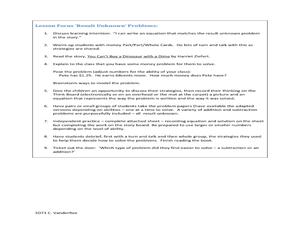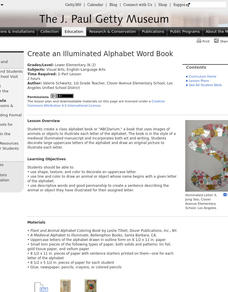Baylor College
Rainbow in the Room
Uncover the science behind the beautiful phenomena of rainbows with a simple demonstration. Shine light through different-sized containers of water as young scientists learn that rainbows occur when visible light is split up into its...
Baylor College
What Is a Neuron?
Your class won't get on your nerves while doing this modeling activity! After teaching the structure and function of a neuron using the included diagrams, give individuals some clay and chenille stems so that they can make their own...
Baylor College
Pre-Assessment: The Brain
Break your class in to the general structure and function of the brain. Brainiacs discuss what they know about it and create personalized brain development timelines. They also take a true-false, pre-assessment quiz to get them thinking...
Baylor College
Moving Air
In lab groups, young scientists place aluminum cans with a bubble-solution cap into different temperatures of water to see what size of bubble dome forms. As part of an atmosphere unit in preparation for learning about convection...
Baylor College
How Can We Find Out What Is in Water?
Using paper chromatography, water watchers discover that several substances might be dissolved even though they aren't visible. In this case, you will prepare a mixture of three different food colorings for them to experiment with. A...
Baylor College
Food Webs
Explore various ecosystems from around the world as your class discovers the interdependence of all living things. Using the provided sets of ecosystem cards, young scientists work in small groups building food webs to demonstrate the...
Baylor College
What Dissolves in Water?
One of water's claims to fame is as the universal solvent. Young physical scientists experiment to discover which materials dissolve in this special compound. You could never be more prepared for teaching this lesson than by using this...
Curated OER
Yellow Pages Ad-dition
Students determine the revenue generated by sample pages from the Yellow Pages. They discuss the value of advertising a business in this venue. They use the local telephone directory and some fictitious ad rates to lead their inquiry.
Curated OER
Pride and Prejudice: Concept/Vocabulary Analysis
Clarify the setting, literary themes, and potential vocabulary issues with a concept analysis resource. With thoughtful explanations of many parts of Jane Austen's Pride and Prejudice, the reference sheet will be a great...
Novelinks
The Hobbit: Writing Assignment
As a culminating assignment for a unit study of heroes that uses The Hobbit as the core text, class members engage in a multi-genre writing project.
Scholastic
Perfect Postcards: Illinois
Connect the geography and history of Illinois using an art-centered instructional activity on the railroads. The railroad connected once-distant places, particularly in the Midwest. Using research, class members create postcards of...
Curated OER
Tuesdays with Morrie: Question-Answer Relationships
As part of their study of Mitch Albom's Tuesdays with Morrie, class groups examine passages from the story and respond to a series of QAR questions.
Curated OER
Larva and Adult Antlion Body Parts
Students identify the major body segments of antlions. Through the use of diagram worksheets, students label the various body parts of the antlion. They review the life cycle of antlions from the larva stage to adult. Several activities...
Curated OER
Literature Book: Rat-a-tat-tat
Students explore choral reading. In this oral reading lesson, students listen to the book Rat-a-tat-tat by Jill Eggleton and participate by reading certain parts chorally and adding sound effects with instruments and noise makers.
Curated OER
Library Lesson Plan: Table of Contents
Third graders create a table of contents. In this library skills lesson, 3rd graders read Welcome to the White House and use the provided worksheet to create a table of contents for the book.
Curated OER
Trivia Books: Louisiana Purchase Bicentennial Celebration
Students detrmine the importance of point of view. They use a well-known fairy tale to explore how changing the point of view changes the whole story. They generate questions from the text they want answered during the unit and construct...
Curated OER
Book Title: You Can’t Buy a Dinosaur with a Dime
Students explore the concepts of multiple digit addition and subtraction. In this addition and subtraction lesson, students read the book You Can’t Buy a Dinosaur with a Dime and then discuss methods for solving a particular math...
Curated OER
Literature Circles
Fourth graders work in groups in order to motivate one another to develop reading comprehension and literacy skills. The skills are built through the sharing of fine literature. They maintain a reading log to keep accountable for the...
Curated OER
Create an Illuminated Alphabet Word Book
Students create a class alphabet book or "ABCDarium," a book that uses images of animals or objects to illustrate each letter of the alphabet.
Curated OER
Incredible Book
Fourth graders examine the contributions made by famous Americans during the American Revolution. They conduct research using a variety of resources, and create an informational page in the form of "Incredible Books" to contribute to a...
Curated OER
Use Literature to Teach Tolerance
Students listen as teachers read a different book or a different passage that focuses on the theme of tolerance. Students then write a paragraph each day to tell how that day's book/passage taught them the importance of tolerance.
Curated OER
Mesoamerican Codex Books
Fifth graders recreate Mesoamerican Codex Books using brown paper bags, paints, glue, an iron, and books on Mesoamerican Glyphs in this 5th grade lesson in the Art classroom. Resource links and book references are provided for lesson...
Curated OER
Figurative Language - Part Two
Students need to use their papers from Part One of this lesson plan. They then write a paragraph for each term. This exercise help them to use these terms in their writing. Using figurative language makes writing more descriptive and...
Curated OER
Using Literature as a Tool to end Name Calling
Students use bibliotheraphy or the guided use of books to help solve problems. They support targets of bullying as they express their feelings and learn coping strategies. By using books, students can then identify, catharsis and have...























